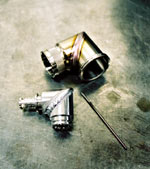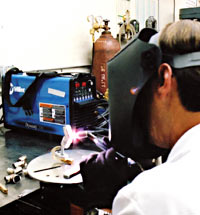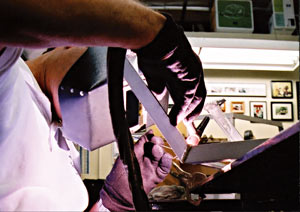When you spend a good share of your time welding electrical fittings for "smart bombs," precision and quality are more than just lofty targets on your workday radar screen. For Bob Hayes, quality is the focus of his daily routine, and it's why his job shop has adopted the slogan, "Quality. The Choice of Many Alternatives."
Hayes owns and operates Bob Hayes Precision Welding in Riverside, Calif., where he has lived since 1986 after leaving the Midwest. His shop specializes in meeting the welding needs of the aircraft and defense industries, as well as the medical hardware industry; three areas where precision welding requires finely honed skills and state-of-the-art welding equipment.
During a career that has spanned more than 20 years, Hayes has come to rely on machines from Miller Electric Mfg. Co. "I'm a Blue man through and through," Hayes says. "You can't make good parts with cheap stuff." The latest object of his admiration is the Dynasty™ 200, Miller's newest AC/DC TIG/Stick inverter. More about that later.
Hayes got his start back in the Midwest, where he learned to TIG weld in two weeks to land a job in the aerospace industryand keep putting food on the table for his young family. "I remember sweating, just going crazy, telling myself, 'God, I have to do this! It doesn't look that hard.' You know, all the things you go through when you're trying to get a job...But in two weeks I learned enough to pass the test and get hired."
Eventually, Hayes moved up to welding supervisor for a company that made commercial and military aircraft exhaust ducts. Along the way, he worked on parts for the Tomahawk cruise missile and Stealth bomber. But after three layoffs in 18 months he headed for the West Coast.
After working in various shops, Hayes launched his own business in 1993, starting out in his garage. "I worked there for three and one-half years, built up a little line of clientele and pretty soon it was time to move on so I opened this shop," Hayes says. He and his two-man crew do 90 percent of their work on aluminum parts.
Why so much aluminum? "Because it's hard and no one wants to do it," Hayes says, matter of factly. He's more than willing to take on the work because he has the people and equipment that produce quality welds.
Steel and Aluminum
When he first started his business, Hayes bought a Syncrowave™ and then moved to an Aerowave® because he needed a machine that he could run off of 15-amp household current. Now, he's using Miller's latest AC/DC TIG/Stick inverter, the Dynasty 200, which was introduced earlier this year. The Dynasty 200 was specifically designed to meet the needs of fabricators who require a full function TIG machine and mechanical contractors who need to weld both steel and aluminum in the field and other hard-to-reach places.
The Dynasty 200 weighs 45 lbs., has a welding range of 1 to 200 amps and a stable AC and DC arc throughout its entire range. It has an AC TIG duty cycle of 40 percent at 150 amps, a DC TIG duty cycle of 70 percent at 150 amps and a DC Stick duty cycle of 60 percent at 150 amps/26 volts.
Similar to the more powerful Dynasty 300, the Dynasty 200 provides the same advanced squarewave technology benefits but at about half the weight. It permits adjusting frequency from 20 to 250 Hz and adjusting electrode negative (EN) duration from 30 to 90 percent. By fine tuning these variables, operators can stabilize the arc, reduce arc wandering, obtain excellent directional control over the arc and puddle, establish the weld puddle faster, precisely place the filler and control bead width.
 |
| Fig. 1—For precision welds on thin metal, Haye reports that the Dynasty 200 allows him to "crater out at 1 amp." |
Like its DC-only cousin the Maxstar® 200, the Dynasty 200 features Miller's exclusive Auto-Line technology. Auto-Line enables the Dynasty 200 to plug into any primary power in the world, from 120 through 460 volts, single- or three-phase, 50 or 60 Hz, which is a welcome feature in the field. Auto-Line works without any manual adjustments or linking mechanisms, which improves reliability. And Auto-Line also maintains a steady welding output even if primary power varies widely, a handy benefit in the factory.
Hayes finds the Dynasty 200 an ideal machine because he relies greatly on pulse welding (the need to change from peak to background amperage rapidly and repeatedly). During the cooling time of the low or background current, the molten puddle shrinks and partially solidifies. A series of overlapping weld fusion nuggets are formed by the pulse peak amperages as the torch moves along the weld axis.
This process is useful whenever welding heat input must be minimized or penetration has to be accurately and repetitively controlled. For out-of-position welding, pulse may prevent weld metal sagging or drop through. In addition, thin metals can be welded with less warpage.
A Problem Solver
"With pulse welding, I'll weld a .0065-in. 4130 chrome-moly diaphragm to a .002-in. 304L stainless ridge. There's no heat sink. I weld that on the upstanding leg," Hayes says.
"On thin stainless, a lot of times you use a pulse just as a way to strengthen the arc. Instead of having the tendency to want to spread out, pulsing focuses the arc," Hayes says. "With 1/2-in. to .001-in. 304 stainless you'll use 100 to 150 pulses per second to focus the arc. You would be in the 65 to 85 percent range of maximum amperage with a background amperage of 35 percent."
How do you know how to set the peak, background and dwell time? "I always tell everybody that I'm not a weld engineer, I'm a metal melter, so it's kind of trial and error. You get used to a feeling," Hayes says. "You look at a part and you say this will take 'x' number of amps. It's just time spent on the job."
Hayes points out that with the advanced technology of the Dynasty 200, "If you're going to pulse something, you have a hundred times more control over your arc. For example, if I'm welding on an aircraft electrical fitting made of 304L, with a straight arc your hand-eye-foot coordination has to be perfect. But with a pulse you can be a whole lot 'lazier' about everything you do because the machine is doing the work."
 |
| Fig. 2—Built-in pulsing controls on his Dynasty 200 DX model provide better arc control on precision welds. |
Preferring not to reinvent the wheel every time there's a pulsing job, Hayes says his shop keeps meticulous records that save time and money. "What we've done is keep records of everything (diameter, thickness, type of angle). And then we refer to peak and background amperage and our percent time, the gas lenses that we use and the amount of pulses per second that we use on a given part," he says. "The more information you have, the easier it is to go to something you've never seen or touched before and say, "Well, we need to be right here.'"
Simple Control Panel
With the Dynasty 200's control panel, setting up for pulse welding is fast and easy. Turning to the panel, Hayes performs a quick check: "With 304 stainless you want to be DC...You skip the next two buttons...We're at six pulses per second...Our peak time is at 15 percent...Background amperage is 35 percent of your peak amperage...and that's basically it."
Since Hayes keeps complete records, "the next time I'm doing this I can go back to something that's similar and be really close when I strike the first arc. So the next time I encounter metal of this thickness, this diameter and this basic configuration, I can be within 1 or 2 percent of the military standards AMS 1595A."
With the type of time-consuming, precision welding that takes place in Hayes' shop, the last thing his crew wants to have to deal with is crater cracking, which occurs when the operator cannot control the welding arc precisely at lower amperages. Crater cracking happens when a weld is allowed to solidify too quickly. The weld cools near the edge and the heat is pulled out from the center of the metal. The center is molten while the edges are solidifying and it starts to shrink.
"With the Dynasty, when you get to the end of the weld you can slowly take your heat out of the arc and that allows the weld to slowly solidify and thus eliminates crater cracking," Hayes says. Knowing when to pulse depends on the part you're trying to weld. "A lot of times you don't need it, but usually what happens is that someone gets into a situation where he says, 'Hey, I can't weld this with the equipment I have. What can I do?'" Hayes says. "Well, there is another technology level that you can step up to. You can weld aluminum now with sharpened tungsten instead of the big ball that you used to have. It's the result of a specific job you have(one you can't do with existing equipment."
 |
| Fig. 3—For quality welding on aluminum, such as this component of a U.S. Army tank, Haye won't use anything else but the advanced squarewave technology of a Miller TIG machine. |
For his specific applications, the Dynasty 200's extended balance control is ideal for aluminum welds. Hayes observes, "With this technology, we can tell the machine how much electrode positive and electrode negative we want. In this particular machine we can go to 90 percent EN. Spending 90 percent of the time penetrating and only 10 percent cleaning improves travel speed and penetration. We're spending 90 percent of the time putting the heat where we really want it(in the part and not in the torch. You have complete control with this machine and you have the ability to set peak and background amperage percentages where you get the cleaning action you need and nothing more."
The Dynasty 200's AC frequency control range of 20 to 250 Hz has drawn rave reviews. "Because we're making our own AC instead of using whatever the power company gives us, we have the ability to change how many times per second we can go from electrode positive to electrode negative. The advantage is that the higher the frequency, the more focused the arc cone gets," Hayes says. "That gives us better control and lets us make the arc go where we want it to go and produce a certain size weld."
Sizing up the Dynasty 200, Hayes gives it high marks. "We have a machine that we can plug into 110 power and do aluminum AC welding. You can plug it into the wall of wherever you want to be. Whatever is coming out of the wall the machine recognizes it and you're ready to go. The technology now is really user friendly. If you take a little tiny bit of time to read the handbook, you'll see that it's extremely simple to use," he concludes.
Dynasty 200 Available in Two Models
Dynasty 200 has two models that offer options professionals demand, either by eliminating unnecessary controls and lowering the unit's price, or by adding features that enhance productivity or ease integration of the machine into an automated application.
The standard model, the Dynasty 200 SD, features: Lift-Arc™ TIG starts, a built-in high-frequency TIG arc starter (no need to purchase an add-on HF unit), dig control for improved Stick arc starts, a built-in gas solenoid valve, pre- and post-flow gas control, standard trigger functions, 14 pin amphenol and international-style connectors.
The Dynasty 200 DX contains all the features of the SD, plus full-featured controls for true pulsing (peak current, background current, pulse width and pulses per second), sequence controls (initial slope, final slope, initial current and final current) and additional trigger functions such as trigger hold, spot timer and 4T.